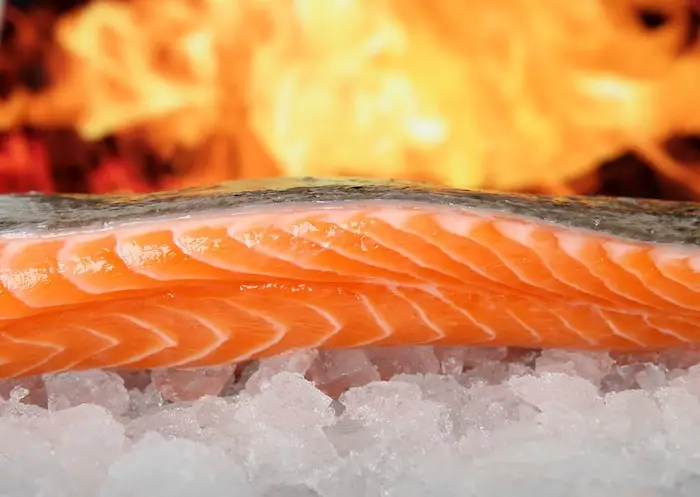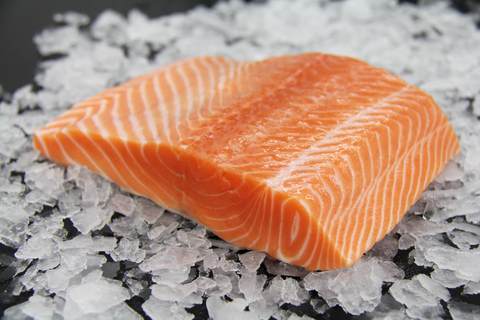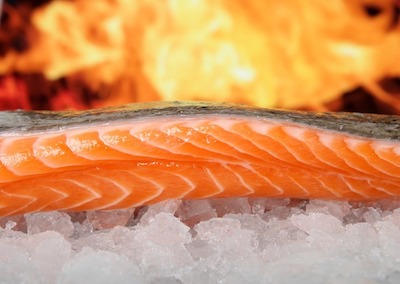We are reader supported. When you purchase through links on our site, we may earn an affiliate commission. Also, as an Amazon affiliate, we earn from qualifying purchases.

There’s something special about the glistening orange meat with white stripes on a perfect bed of sushi rice or wrapped inside a Nori sheet. Salmon is one of the most popular types of raw fish that tastes amazing when paired with seasoned rice. However, you must be careful while choosing to avoid any food-borne illness.
What kind of salmon is best for sushi? You should avoid wild salmon as they mostly thrive in river water that contains different types of nasty parasites. Make sure you always use farmed salmon that are carefully bred and categorized as sushi-grade. They are sold frozen at a specific temperature to ensure safety.
When eating raw salmon sushi at a restaurant, make sure you eat only at a reputed place that serves good quality fish. When in doubt, you may ask the chef from where they get the fish. If you are planning to make salmon sushi at home, always buy sushi-grade fish from a reputed fishmonger.
Most of the fishermen will freeze the fish at a certain temperature as soon as they are out of water. This method is known as flash freezing, and it helps in killing any parasites. It also keeps the freshness and flavor intact so that the flesh does not disintegrate or decay.
Difference Between Wild And Farm Raised Salmon
If you have not heard of anything like this before, here some useful information for you. Just like onions, salmon can be cultivated in farms, but they are also available in the wild environment. Let’s take a look at some of the critical differences between wild and farm-raised salmon.
Farm-Raised Salmon
If you hear the term ‘farm-raised’ salmon, it typically means that the fish was raised in some aquatic farming operation. However, the salmon farms vary widely in terms of size, breeding practice, location, and several other things.

In terms of color, the farmed salmon differ in the same way as the carrot cultivated in California looks different from the carrot grown in New Jersey.
Ever wondered what the farm-raised salmon tastes like? This is what most people relate to when they think of raw salmon. It is usually fatty, with a mild flavor. The color typically ranges from soft pink to orangish.
Furthermore, the farm-raised salmon has a lot of Y stripes striations of fat, that makes the flesh flaky and easier to separate with the help of a fork.
Wild-Caught Salmon

Just as the name implies, the wild-caught salmon is caught from the oceans, specifically the Pacific ocean region around New Zealand and Alaska. The fishermen take out their boats deep into the waters to catch these fish in their natural habitat.
If you purchase wild-caught salmon, you are supporting the small fishing operations across the small coastal towns around the world. This may or may not be legal.
While the wild-caught salmon come with their own risks, people prefer buying this type of fish for their authentic flavor. No wonder, a free and happy fish roaming in the ocean delivers a more salmony flavor and color.
In appearance, they come across as more vibrant and intensely-colored than the farm-raised ones. You will find more of red-orange hue than pink. When it comes to the flavor, they are much more complex and savory.
Signs That Indicate The Freshness Of Salmon In Sushi
Smell:
The first indicator that differentiates sushi-grade fish from others is the smell. For long, sushi experts have been in debate whether salmon should smell like the ocean or without any smell at all. Just do a small test – bring a piece of salmon to your nose to check the scent.
If it smells slightly fishy or salty, it should be considered as healthy. However, if the fish smells too fishy to fill the room, then it is probably not sushi-grade, and you should best avoid it.
Appearance:
If you are new to eating raw fish, you may not be able to tell the difference, and all piece may look the same to you. However, if you look closely, you can see the fine details that reveal the freshness factor of the raw salmon slices.
Fresh or sushi-grade salmon should be shiny, nearly translucent and without any whitish milky slime on the top. You should look for pieces that look like a jewel when placed atop a bed of rice.
Color:
Talk about color and most of us would unanimously say orange as the color indicating the flesh of salmon fish. If you think that more orange means the fish is fresher, then you are mistaken. There are actually two tell-tale signs when it comes to color.
There’s a slight difference in color between farmed salmon and wild salmon. The later has a more reddish tone to the flesh due to the free ocean diet that has high amounts of carotenoids. The farmed salmon, on the other hand, are fed dry pellets, and this lends a light orange color to the meat.
In some farms, they use some type of coloring to make the salmon slices look more appealing and fresh. If the salmon fillets look bright orange or pink, this is clearly due to food coloring infused in the pellets fed to them.
So, remember that color is not necessarily the indicator of freshness in the case of salmon sushi. Just take care that the color does not look off. As long as it is bright and shiny, the salmon is good to go.
Texture:
Before you start savoring the lovely pieces of salmon sashimi placed on nigirizushi or rolled inside a Nori sheet, spend some time checking the texture. To do this, poke the flesh with your finger to cause an indentation. If it resumes the shape quickly, then the fish is fresh and solid.
There should not be any signs of degradation on the fish, such as rips or pockmarks. When you visit a sushi bar, pay attention to how the chef handles the fish. A restaurant that uses sushi-grade fish should not smell fishy as you walk in. It should smell of cucumber and watermelon.
If the chef does not handle fish properly, this may cause deterioration in quality. A good place is where the chef slices the fish just before preparing your sushi. If there are pre-sliced pieces, it is better to avoid that place because sliced fish oxidizes quickly.
Things To Consider Before Buying Sushi-Grade Salmon
If you are looking for healthy choices, I would recommend the North American species that vary in price, color, and flavor but they are all healthy for consumption. Chinook is considered as the king of salmon and it is highly prized for its fat content that lends a buttery texture to the flesh.
Sockeye is another fattier fish that has deep-red flesh and strong flavor. It tastes great when grilled or smoked. Coho is slightly milder in taste and also lighter in color. Both chum and pink are small sized and they are often sold as canned salmon.
The Atlantic salmon (a farmed species) is one of the most common varieties of salmon fish you will find in the market. Other recommended options are Farmed Faroe Island Salmon, Fresh Farmed SAIKOU Mt. Cook Salmon, and Farmed Canadian Salmon to name a few.
Interestingly the wild Alaskan salmon that spend most of their lives in the oceans have lower levels of toxins. As a result, salmon eggs (Ikura) from wild Alaskan salmon are extremely popular. The coastal salmons may have varying degrees of toxins depending on their feed. As a result, most people prefer eating the farmed salmon species that are fed in regulation.
Salmons caught from the ocean are immediately flash frozen because even the freshest ones may have parasites that need to be killed. Flash freezing helps in destroying the parasites completely, and the frozen fish can stay good up to 4 months when stored in optimum conditions. The canned wild salmon may be a good and economical option. I would suggest that you look for BPA-free cans or pouches.
Related Questions
Why are salmon fillets orange in color?
Salmon is orange due to carotenoids, orange pigments that are also found in carrots. These pigments are rich in antioxidants that help in combating the effects of free radicals. Some farmed Atlantic salmon are given synthetic astaxanthin in their feed to make their flesh look more orange and appealing.
Are farmed salmons fattier than the wild ones?
Yes, because they are fed a selected diet that is rich in vegetable oils and grains. The higher fat content is preferable in fish because that means the flesh is easier to cook and it can also retain the moistness.
Is fresh salmon safe to eat?
Unfortunately no, because fresh fish like salmon may contain bacteria that can make you sick unless destroyed. Another issue is cross-contamination caused when a healthy fish is cut on the same board with the same knife used for cutting a fish containing parasites. As a result, it is essential to buy sushi-grade fish only from trusted sources.
Where can I buy sushi-grade salmon online?
Whether you are looking to buy salmon poke cubes, Ikura, or high-grade salmon fillets, I would recommend Catalina Offshore Products. I frequently purchase from them because the quality of fish is great and they offer good customer service. They also provide a good selection of other fish varieties.
See Also:
30 Good Ideas for Sushi Roll Fillings
Catalina Offshore Products Review – All You Need To Know
What Does Takoyaki Taste Like?

